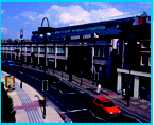
Sheffield?s Cultural Industries Quarter (CIQ) is a 30 hectare area on the edge of the city centre zoned in 1988 for businesses in cultural production, explains Simon Evans.
In a city better known for its closing mines and steelworks, this was dubbed by the trade minister of the day ?spendthrift and lunatic?, but now that creative industry and cluster development policies are core to the government?s regional agenda it is seen as far-sighted.
Regeneration efforts in the CIQ since then have achieved over £150m of public and private sector investment. It comprises 250,000 sq. ft. of managed workspace, all with waiting lists. 1,200 new jobs in 120 cultural businesses, 1,000 new student bed spaces, and 1,500 media training places per year have been created. The site is also home to the four-screen Showroom cinema, the National Centre for Popular Music (now a music venue), Site Digital Imaging Gallery, four night-clubs and a host of practitioner-based specialist business services. Its extensive events calendar includes the Sheffield International Documentary Film Festival, and Lovebytes Digital Arts Festival.
There are still unused factories, but from a zero base Sheffield CIQ is now a significant creative business cluster. Even the City Council has made a healthy return on it, with the increase in realised capital values and rentals of Council land and buildings surpassing their input in grants and officer time.
But might it have happened anyway? Is the process repeatable elsewhere? The Sheffield experience suggests that the key ingredients might be:
People and their partnerships, institutions, organisations, companies, clubs and networks:
the key people are the cultural entrepreneurs whose energy and creativity fuel and justify the whole process, and the development workers whose networking and partnership-brokering make the whole greater than the sum of its parts. Making products, services and experiences for pleasure, profit or policy:
even within a highly specialised cluster diversity is critical. A bland, high-tech new media centre is unlikely to be as successful as a ghetto of non-profits and start-ups.
Land, roads and buildings:
the CIQ?s flagship managed workspaces are based on one-off capital endowments, with a low or nil revenue funding requirement. They house commercial and arts activity under the same roof. Non-profit structures with freeholds help protect key cultural businesses from being squeezed out by rent increases.
Training programmes, incubation programmes, commissions for artists, marketing, networks and high-level championship:
networks are particularly important. In order for partnerships to emerge and projects to develop, people need to meet each other formally and informally.
Public and private events, festivals, shows, etc.:
the point of buildings is the activity that takes place inside and around them.
Information systems: websites, newsletters, archives, mailing lists, directories:
the self-image of the cluster and its reputation elsewhere, are key assets.
A cluster is always in flux, making it difficult to analyse and represent. But next year, we will host a comprehensive effort to do just that: the first Creative Clusters conference, a hands-on event bringing together cultural quarters, media centres and creative industry agencies. In a policy arena often noted for its hot air, we promise to call a spade a spade.
Simon Evans is a cultural entrepreneur and consultant who has been based in Sheffield CIQ since 1985
e: simon.evans@workstation.org.uk.
For more information on the Creative Clusters Conference w: http://www.creativeclusters.co.uk



